Article contents
The Development of the Roman Stage: A Missing Link Restored
Published online by Cambridge University Press: 23 January 2009
Abstract

- Type
- Articles
- Information
- Copyright
- Copyright © International Federation for Theatre Research 1979
References
Notes
1. Vitruvius' statement is in De Architectura, VII, v, 2. See Von Cube, G., ‘Römische Scaenae Frons in den Pompejanischen Wandbildern IV, Stils’, Beitrage zur Bauwissenschaft VI (1906), pp. 28 ffGoogle Scholar; and Curtius, Ludwig, Die Wandmalerei Pompejis (Leipzig, 1929), p. 180 ff.Google Scholar
2. The Room is discussed in Gianfilippo Carettoni's article ‘Due Nouvi Ambienti Dipinti Sul Palatino’, Bollettino d'Arte (1961), pp. 189–99.Google Scholar
3. The excavations at Oplontis are reviewed in Alfonso de Franciscis' Pompeian Wallpaintings in the Roman Villa of Oplontis (Recklinghausen, 1975).Google Scholar
4. Apuleius, , Metamorph, I, 8 and X, 29.Google Scholar See also Bieber's, MargareteHistory of the Greek and Roman Theater (Princeton, 1961), p. 180.Google Scholar
5. See Rumpf, Andreas, ‘Die Entstehung des Römischen Theaters’, Mitteilungen des Deutschen Achäologischen Instituts, III (1950), 40–50.Google Scholar Also Livy, XL, 51, and Pliny, , Nat. Hist., 35, VII, 24.Google Scholar
6. Vitruvius, op. cit.; V, v, 7.
7. See, for example, the upper section of a wall from the House of the Vetti (Anderson no. 26469); a similar painting from the House of Lucretius Fronto (Anderson 24860); or a wall, now lost, from the House of Livia on the Palatine, illustrated in Curtius, op. cit.; p. 89.
8. Vitruvius, ibid.; V, v, 7 states ‘We can observe … those who … when they wish to sing with a louder tone, turn to the wooden scenery, and, with this help, gain resonance for their voice’.
9. See Carettoni, , op. cit.; pp. 195–6Google Scholar, or Curtius, , op. cit.; pp. 105 ff.Google Scholar
10. This theory was developed by Fiechter, Ernst in Die Baugeschichtliche Entwicklung des Antiken Theaters (Munich, 1914), pp. 100 ff.Google Scholar
11. In addition to considerable archaeological evidence, the form of the paraskenia stage is reproduced in several vases, notably the ‘Iphigenia’ Vase now in the Louvre, and the vase now in Würzburg which is reproduced here as it was reconstructed by Bulle, H., Eine Skenographie, Winckelmanns-Program (Berlin, 1934).Google Scholar See also Bieben, , op. cit.; pp. 66–9Google Scholar, and Webster, T. B. L., Illustrations of Greek Drama (Phaidon, 1971), p. 101.Google Scholar
12. For a discussion of the production of Greek plays in Italy, and of the relationship between New Comedy and the paraskenia stage, see amongst others, T. B. L. Webster's Introduction to Illustrations of Greek Drama.
13. Bulle, H., ‘Untersuchungen an griechischen Theatern’, Abhandlungen Bayer. Akad. Wissenschaften, phil. hist, klasse, Vol. XXXIII (Munich, 1928), pp. 152, 159 ff.Google Scholar
14. For a discussion on the relationship between Italian and Greek plays, see Sandbach, F. H., The Comic Theatre of Greece and Rome (Chatto Windus, 1977), p. 103 ff.Google Scholar
15. Donatus records that in his time (c. a.d. 350) female parts in Terence were played by actresses.
16. The Pompeian theatre, as well as other later examples, also had stairs connecting the stage to the orchestra, a strong indication of its debt to the phylakes stage which, unlike Hellenistic theatres, used such stairs.
- 2
- Cited by


